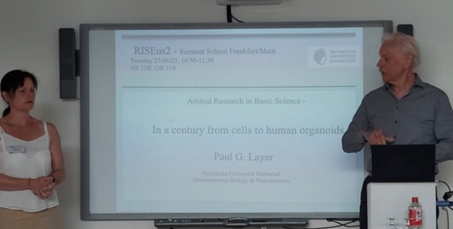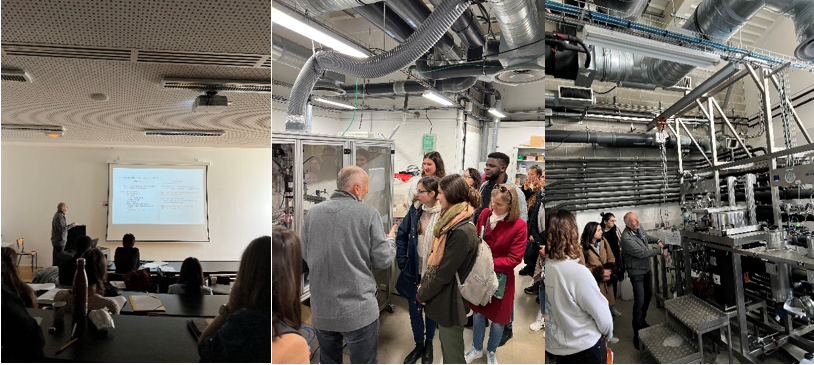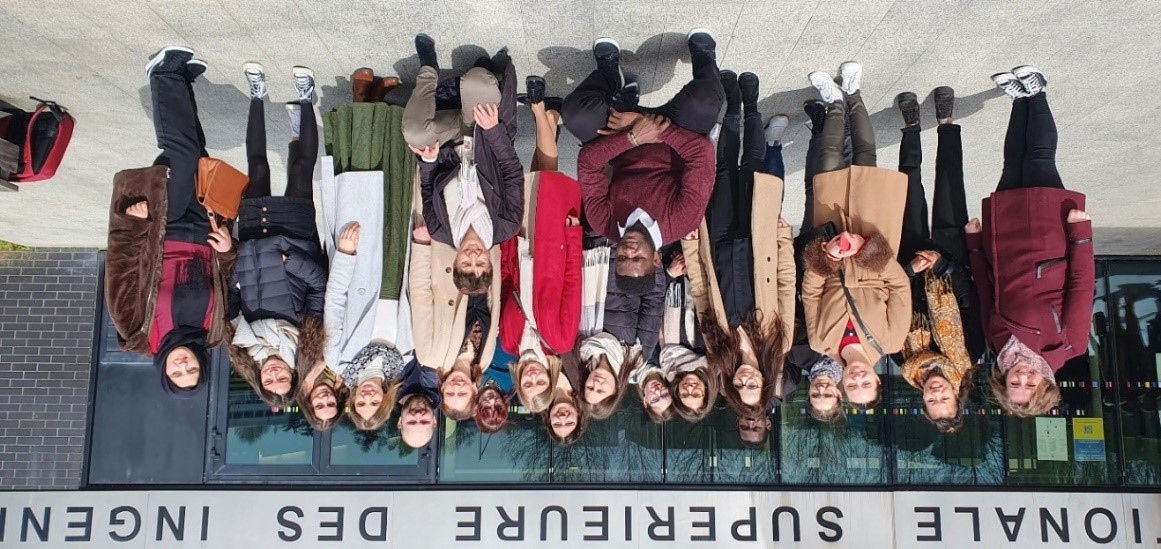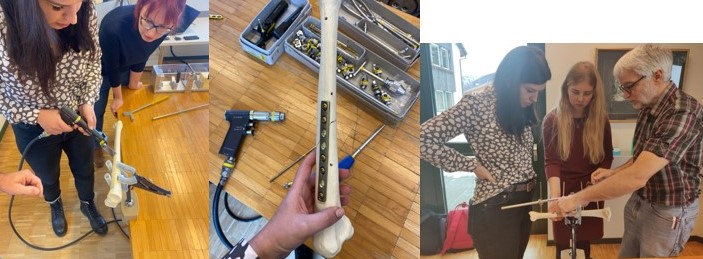
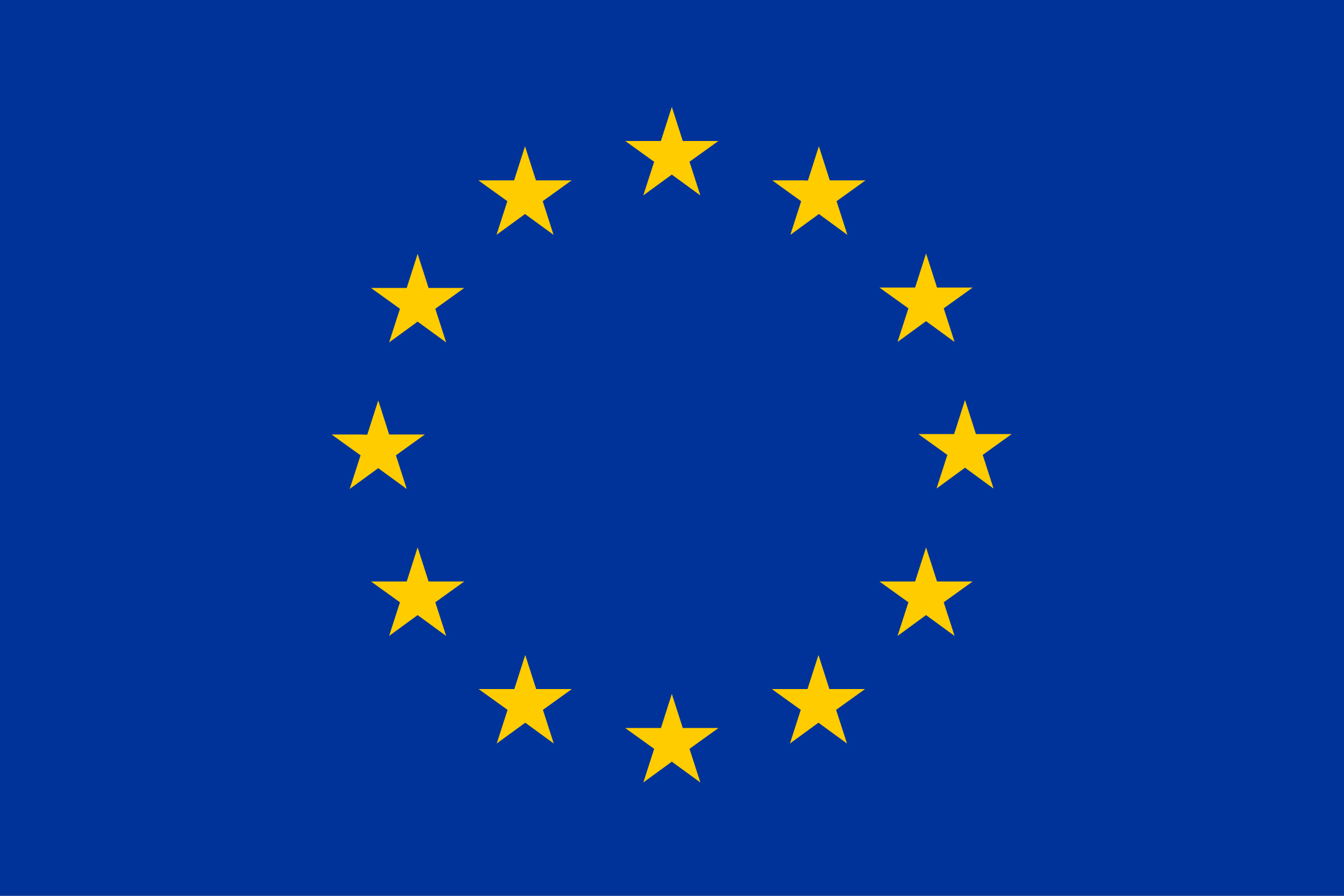

“Rising competitiveness of early stage researchers and research management in Latvia” (RISEus2)
H2020 WIDESPREAD-05-2020: Twinning project GA No 952347
Final RISEus2 Conference
6th of October, 2023, Zunda Krastmala 8-108, Riga, Latvia
RISEus2 RTU RBIDC organized the RISEus2 Final conference in conjunction with the RTU Faculty of Materials Science and Applied Chemistry international conference “Materials Science and Applied Chemistry” on 06.10.2023 with the registered 79 conference participants. The world-leading scientists from RISEus2 consortium partner organizations AO Research Institute Davos (ARI), Institut National Polytechnique de Toulouse, Centre Interuniversitaire de Recherche et d'Ingénierie des MATériaux (INPT-CIRIMAT), Goethe University Frankfurt (GUF) and RISEus2 Advisory board member organization University of Aveiro (UA) participated in the conference as invited keynote speakers. The RISEus2 Final conference consisted of two sessions: the invited keynote speaker’s “RISEus2 Session” and RTU RBIDC leading staff and early stage researcher’s (ESRs) session “Biomaterials Research”. During the RISEus2 Session, all four invited internationally recognized scientists - Prof. João F. Mano, Dr. rer. nat. Anja Heselich, Prof. Mauro Alini and Assoc. Prof. Stéphanie Sarda presented current research advancements and future trends in the biomaterials and tissue engineering field.

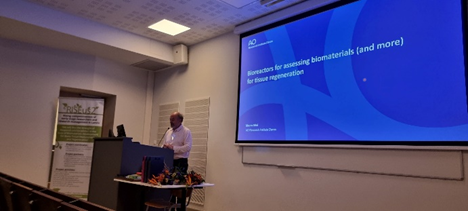
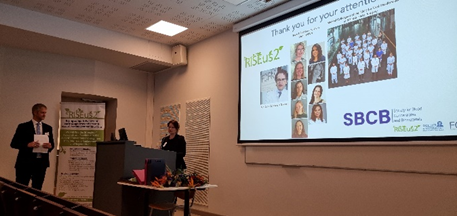
RISEus2 3rd Summer School “How to establish in vivo experiments”
26-30 June, 2023, Goethe University Frankfurt, Germany
The 1st day of RISEus2 Summer School “How to establish in vivo experiments” started with a meet up of all participants. The main goal of the first day was to familiarize all the ESRs to the functioning of the lab that is connected to the clinic. At 10 h Prof. Dr. mult. S.Ghanaati and Prof. Dr. mult. R. Sader gave a welcome speech and the Summer School has officially started. First, all the participants shortly introduced themselves and their current projects, then Dr.rer.nat. A. Heselich and Dr.rer.nat E. Dohle presented the necessary safety measures that need to be considered during the entire stay in the premises of the clinic. After the lunch break and ESR networking, the overall history and capabilities of the FORM-lab“ were presented and connected to the current developments and the success of the lab. Together with Dr.rer.nat. A. Heselich and Dr.rer.nat E. Dohle, all the participants went to the tour of the lab and the joining part of the clinic. A very successful day has ended with an exciting visit to the Main tower with a panoramic view of Frankfurt.
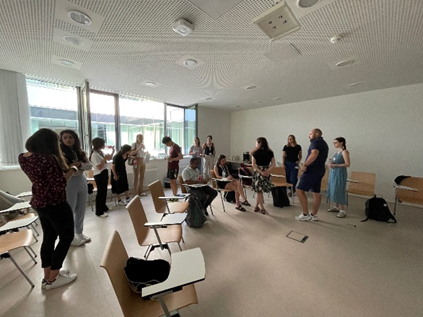

RISEus2 Summer School – 1st day morning networking and the welcome speech by Prof. Dr. mult. S.Ghanaati.
For the second day of RISEus2 Summer School Dr.rer.nat Eva Dohle delivered the first lecture on “In vitro experiments and translational research - Biocompatibility, Methods for replacing animal models”. The lecture provided a brief overview of the in vitro application of biomaterials. Moreover, some examples of biomaterials as medical devices were demonstrated. The most exciting part of the lecture was testing bone substitute biomaterials for biocompatibility, wherein step by step approach was illustrated. A significant debate was also done on the in vitro models, where three group testing method were discussed. Furthermore, Dr.rer.nat Dohle showed a case study – Development of osteosynthesis material for pediatric maxillofacial surgery. The case study described how effective in vitro analysis reduces the sample count for animal studies.
|
|
|
In the next session, prof. Dr. Paul Layer gave the following talk on spheroids or organoids as a model for in vitro analysis. The lecture started with the historical background on organoids. Professor Layer described the differential adhesion hypothesis, which was stem cell biology's backbone. The presentation briefly introduced stem cells, totipotent cells, pluripotent cells, and induced pluripotent stem cells.
RISEus2 Summer School –2nd day second lecture by Prof. Paul G. Layer on Animal Research in basic science.
After the lunch break and networking, the day continued with the lecture by Dr.rer.nat. A. Heselich on in vivo research differences and demands for animal and human studies (see Figure 8). Animal models for soft and hard tissue regeneration were described in detail. Moreover, a brief description of the relationship between animal models and human studies was presented. The presentation underlined the use of organoids as an alternative model for biomaterial testing.
The last part for the 2nd day session was the seminar (Part I) on how to design an experiment, which rules and laws apply, and what mandatory steps to take in advance. In this interactive session, ESRs, together with Dr.rer.nat. A. Heselich have selected the materials and described what processes are required.
On the morning of the third day, the RISEus2 Summer School participants presented their experimental plans based on the tips and examples given the previous day. It was necessary to show how the experiment will be conducted, clearly defining the research question and purpose. Also, participants mentioned the necessary documents that must be obtained in order to be able to perform all the necessary experiments. It is essential to thoroughly research and understand the relevant rules and laws specific to the experiment's domain to ensure compliance and ethical conduct throughout the research process.
After the lab, participants and lecturers were welcomed for the lunch break and for further networking. After the lunch, all participants of the RISEus2 Summer School were invited to a city tour “Let`s Visit Frankfurt” prepared by the organizing team. Accompanied by a guide, the participants had the opportunity to see the Frankfurt church, the main square of the city, and many other highlights.
On the 4th day morning, Dr. Bennardo presented his research on "In vivo applications of PRF in clinical therapy". He shared his experiences with PRF utilization, particularly in dentistry. Subsequently, Lena Schmeinck and Boyo Louisa presented their in vitro and in vivo studies on PRF, providing comprehensive technical insights into its application for regeneration and anti-inflammation purposes. During the question and answer session, participants engaged in discussions with the PRF researchers, delving into specific aspects of their research and experiments. Later, Kamelia Parkhoo presented her findings on utilizing PRF as anticancer implants through in vitro experiments.
In the afternoon, a second part of the hands-on workshop was organized. The participants were again divided into two groups and rotated their tasks. The group that prepared PRF on the previous day, went with V. Hoffman to work with magnetic beads in order to collect primary cells, and the other group went to work with PRF. Following the demonstrations, participants performed part of the experiments on their own. In this manner, everyone gained the lab experience from the FORM lab had hands-on practice.
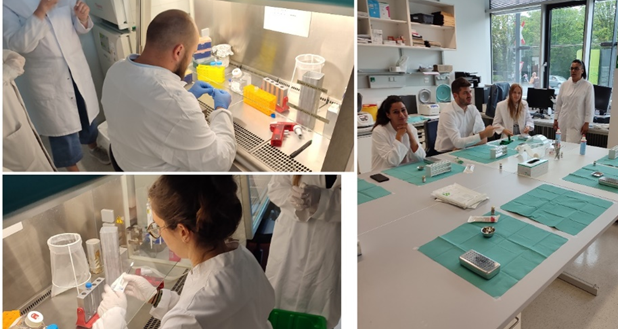
4th day workshop of in vitro experiments (left) and PRF preparation training (right).
In the beginning of the last day of RISEus2 Summer School “How to establish in vivo experiments”, presentation was prepared and given by Dr. Sarah Al-Maawi. Dr. S. Al-Maawi is a leading researcher in the field of in vivo studies and she shared her knowledge and experience by introducing participants with animal research. Dr. Al-Maawi had a very exciting presentation of how animal studies are structured, what are the possible drawbacks and what could be the correct algorithm when planning animal studies. Her presentation ended with an exciting discussion.
After the presentation, Dr. Al-Maawi followed the participants to the laboratory for the hands-on laboratory practice. During the workshop participants were able to practically use their newly received knowledge. Laboratory work included preparation of the previously sacrificed Wister rats for anaesthesia and adequate administration of the drug injection. Once the animal has undergone the anaesthesia, the resection and biomaterial insertion was done by each ESR. The complete procedure ended with everyone learning how to perform the suiter of the tissue. In this manner, all of the participants of the Summer School prepared subcutaneous animal model by using previously sacrificed Wister rats.
First half of the last day ended with the lunch break followed by the closing discussion and fare well given by Prof. Dr.mult. Shahram Ghanaati. He discussed the overall impressions of the Summer School with the participants and gave them last kind words and suggestions about animal studies and research in general.
RISEus2 3rd Winter School "Materials in vitro"
16-18 May, 2023, Riga Technical University, Rudolfs Cimdins Riga Biomaterials Innovation and Development Center, Latvia
The 1st day of RISEus2 3rd Winter School “Materials in vitro” started with a meet up of all participants where everyone was networking over the morning coffee. At 10 h prof. Janis Locs gave a welcome speech and the Winter School has officially started. First presentation was given by Prof. Abhay Pandit, Centre for Research in Medical Devices (CÚRAM), Ireland. His presentation was divided in two parts. In the first part Prof. Abhay Pandit shared his own experience in the scientific world by telling his life and success story and by sharing some useful tips and tricks for young ESRs. The main idea of the presentation “Career Success: Illusion or Reality” was to reveal that motivation, perseverance and self-confidence are the crucial parts of becoming a well-known scientist in the academic and non-academic circles. During the second part of his lecture, prof. Abhay Pandit gave more scientifically-focused talk on “Regenerative Response Induced by Biomaterials Systems”. During the lecture he presented the most current studies in his Research center, revealing some results and future prospective.
Afternoon of the 1st day continued with the lecture of Dr. Audrey Tourrette Diallo, Université Paul Sabatier, CIRIMAT, Toulouse, France. about the lecture was focused on the “Characterization of surgical wound dressing based on biopolymers”, where Audrey as a group leader revealed some novel investigations and characterization of biomaterials developed in CIRIMAT laboratories. Lecture ended with an open Q&A session that lead to a broad discussion about future perspectives and drawbacks regarding the calcium phosphate group of biomaterials. The next presenter was Prof. Christèle Combes, also a representative of Institut National Polytechnique de Toulouse, CIRIMAT, France. Prof. Christèle Combes continued on the previous talk, by explaining the novel amorphous biomaterial systems developed in CIRIMAT and their in vitro characterization. Moreover, a full in-depth molecular and biomaterial-living system interaction pattern of developed biomaterials was discussed.
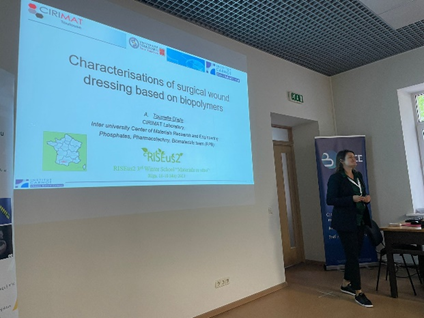
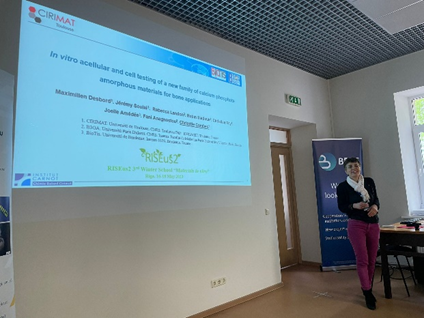
RISEus2 Winter School – 1st day afternoon lecture of Dr. Audrey Tourette (on the left) and Prof. Christèle Combes (on the right) from Institut National Polytechnique de Toulouse, CIRIMAT, France.
After the lectures, participants and lecturers were welcomed for the lunch break and for further networking within young scientists, where everyone continued the started discussions in a more relaxed atmosphere. After the lunch, all participants of RISEus2 Winter School were invited for a surprise social activity prepared by the organizing team from RTU Rudolfs Cimdins Riga Biomaterials. All participants, (young researchers, PhD students, professors, lecturers) were divided into three teams to play a Lasertag game. Social activity was full of funny moments combined with competing atmosphere and physical training. At the end, participants were introduced with a full breakdown of the game statistic to find out who is the best one and the most accurate one. Indeed, friendship has won according to prof. Dagnija Loca’s opinion!
The 2nd day of the Winter School started with Prof. Mauro Alini’s (AO Research Institute Davos, Switzerland) lecture that was divided in two parts – 1) “From football to bioreactors - true or science fiction?” and 2) "How bioreactors can be used for biomaterial development?”. In these lectures Prof. Alini shared his own experience during his scientific carrier, how initially unrelated things or people can inspire and lead to great discoveries and new technologies such as bioreactors for bone regeneration.
The following lecture of the second day was given by Dr. Sergio Uribe, Assoc Prof/Leading Researcher (Dept. Conservative Dent. and Oral Health & BBCE, Riga Stradins University, Latvia), titled “Exploratory Data Analysis for Research: Examination and management of In Vitro, In Vivo, and Clinical Data”. Dr. Uribe gave an insight on how to avoid creating bad graphs and what is needed for a graph to be considered good. Another important aspect of the lecture was how to sort the data in databases and what are good examples of them. Afterwards, Dr. Uribe shared some useful websites (e.g., data-to-viz.com) for making graphs, which was followed by an introduction of programs - R and Rstudio, used for data sorting and graph making. After the introduction of these programs, there was a workshop to gain practical knowledge.
The third day of RISEus2 3rd Winter School on “Materials in vitro” started with the lecture from Dr. rer.nat. Anja Heselich on “Bioactive natural drug delivery system PRF in translational research and clinical use”. Dr. rer.nat. Anja Heselich started with an introduction to what PRF is and how it can be obtained. She also emphasized that it contains a concentrated mixture of platelets, growth factors, cytokines, and other bioactive molecules that are released upon activation. Dr. Heslich has brought to attention that in translational research, PRF has shown promising results across various medical fields and it has been extensively studied in dentistry, oral and maxillofacial surgery, dermatology, orthopaedics, and wound healing. The versatile nature of PRF allows its application in different forms, including membranes, gels, and sutures, depending on the specific clinical requirements. During the lecture, the participants found out that one of the key advantages of PRF is its ability to provide sustained release of growth factors and other bioactive molecules, promoting a prolonged healing response. Additionally, as PRF is derived from the patient's own blood, it eliminates the risk of disease transmission or immunological reactions.
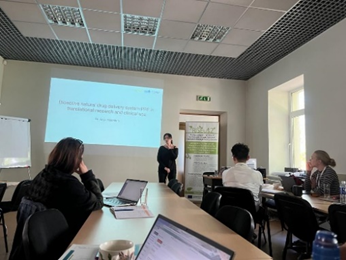
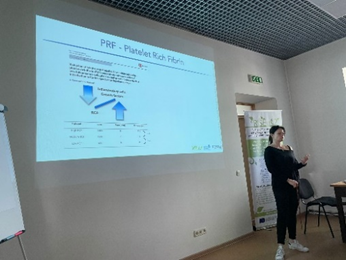
RISEus2 Winter School –3rd day morning lecture of Dr Anja Heselich on platelet-rich fibrin.
Dr. Kristaps Klavins (associated professor at the RTU) gave a following talk, which was an introduction of metabolomics and how to use this tool in the biomedicine. From the lectures, participants learned what is encompassed by omics data, how to generate it and how to choose suitable software to conduct data analysis. In the afternoon, hands-on workshop was organized to share the knowledge among ESRs, of using metabolomics for deep evaluation of biological information.
During the workshop participants got the chance to analyze real metabolomics data acquired by the team of Prof. Klavins. All participants practiced how to use MetaboAnalyst 5.0, as the tool for metabolomics data assesment. In the end, each group gave their report and presented for all the participants of the school.
RISEus2 2nd Summer School "How to write scientific reviews"
21-25 November, 2022, AO Research Institute (ARI) Davos, Switzerland
The 1st day of Summer School: The school started with a welcoming presentation held by Dr. Matteo D'Este, Nora Goudsouzian, and Nunzia Di Luise. They illustrated the uniqueness characteristics of Davos city, as location for a number of worldwide renowned research institutes, as recognized alpine ski resort, and as hosting city of the annual World Economic Forum meeting. Then, they illustrated the agenda of the week and gave some practical information. After that, Prof. Dr. Geoff Richards (Director AO Research Institute Davos - ARI) gave a presentation on the Institute, including history of the AO Foundation and ARI, current ARI research activities, and main achievements of the Institute.
In the second part of the morning, Prof. Mauro Alini (vice Director ARI) gave a lecture on "Importance of writing review papers". The presenter organized an interactive session in which school participants were requested to discuss on a list of provided insightful points on common problematic and controversial issues in writing and publishing a review paper.
In the afternoon a first group of five school participants presented an outline of the review article they aim to write. Baiba Šlisere presented on dysregulation of adaptive immune responses in mature B cell malignancies. Afterwards, Anna Galotta talked about the possibility of using mussel for biomedical applications and ultimately, how a waste becomes a bone substitute candidate. Signe Zemjane discussed about low crystalline calcium phosphate biomaterials doped by metallic ion and presented a potential table of contents for her review. In the following, Sylvain Le Grill presented on the mechanical behavior of amorphous calcium phosphate. In the end, Laura Mecchi discussed about the rationale behind the choice of biomaterials for bioreactors in cartilage tissue engineering.
In the following, Prof. Dr. Martin Stoddart (Program Leader Regenerative Orthopaedics, Focus Area Leader Progenitor Cell Biology and Mechanoregulation) gave a lecture on "Research metric and Ethics". The presenter illustrated different ways to measure quality and impact in research, with a strong accent on the limitations of each type of metric. Additionally, alternative approaches giving more importance to achievements rather than pure impact factor were illustrated.
In the last session of the day, school participants were provided of individual codes for Nature Masterclasses on-line courses and requested to attend an individual session on "Writing and Publishing a Review Paper".
The 2nd day of Summer School: The day started with the second session of presentations from 12 participants, who introduced the outline of their review papers. Oskars Radzins presented on the predictive method software in orthognathic surgery to find out if a singular method is applicable in all cases regardless of the type of surgery. Alise Švarca talked about strontium ranelate local delivery for osteoporosis aiming to compare different strontium ranelate systems. Marion Merle discussed about amorphous Calcium-Phosphate and Calcium Carbonate wanting to compare their formation mechanisms and their multi-scale structure. Artemijs Ščeglovs continued with his presentation about hydrogels deriving from natural materials and polymers as a replacement of antibiotics due to antibiotic resistance. Kamelia Parkhoo talked about platelet rich fibrin and its role in bone tissue engineering, osteogenic differentiating, wound healing and bone formation. Afterwards, Lena Schmeinck discussed about naturally derived biomaterials for regenerative medicine applications. Daniele Zuncheddu review paper will be an overview of preventative measures and available therapies of diseases, discussing advantages and limitations, as well as if it is better to continue in this direction or to try to focus more on the etiology of these diseases. Athanasia Pylostomou pointed out that there is a gap in the literature about calcium phosphate cements for bone cancer treatment and why these injectable materials are more advantageous over the traditional treatment methods. Zeliha Esra Cakmak continued talking about her review on electrospun fibers for nerve tissue regeneration. Abraham Abbey Paul talked about the benefits of alginate and its limitations and how a composite formation can be beneficial. Then Marika Mosina talked about bioceramics doped with ions wanting to review on various ceramics. In the end, Agneta Veženkova informed the audience about her intention to write a review on injectable biodegradable gelatin methacrylate/calcium phosphate composites for bone tissue engineering.
After the presentations, Prof. Dr. Sibylle Grad (Deputy Program Leader Regenerative Orthopaedics, Focus Area Leader Disc and Cartilage Biology, ARI) gave a lecture on the definition of the scope of a review article. Many useful take-home messages were presented on how to choose a topic of review. After Sibylle Grad's lecture, the school participants were divided in groups and a review article was given to each group to discuss what participants expected the content of the article to be according to the title, and if in the end it matched participant's expectations.
In the afternoon due to an unexpected issue, the planned lecture from Prof John S. Oakey didn't took place. As replacement, a guided tour of the ARI facilities was organized. The participants were accompanied through 6 laboratories and facilities around the Institute and 10-minutes presentation, followed by 5-minute discussion took place at each station.
In the evening a social dinner with all school participants and presenters was organized. Participants and presenters could talk and discuss about different aspects of their career and personal experience in a more friendly and convivial environment.

The 3rd day of Summer School: The day started with a social activity consisting in walking around Lake Davos. Inspired by the beauty of the surroundings, participants could talk and share their career experience and expectations in a more open situation. After the walk, participants were welcomed to “Kaffee Klatch” restaurant for lunch.
In the afternoon started with the second session of online individual training with Nature Masterclasses Course. The day ended up with a discussion panel on the completed Nature Masterclass Course, led by selected school participants (Lena Schmeinck, Laura Mecchi, Artemijs Ščeglovs, and Oskars Radzins) and moderated by the instructors. Panel organizers prepared a list of topics to trigger discussions on the most relevant training points, including author competence requirements, figure creation, recentness of reference literature and keywords connected with good review writing. Inclusive discussion was fostered, involving all participants with an open and respectful atmosphere. Discussion points were considered complete once a conclusion consensus was achieved.
The 4th day of Summer School: Gregor Miklosic (PhD student, Regenerative Orthopaedics, ARI) and Dr. Geraldine Guex (Research Scientist, Regenerative Orthopaedics, ARI) gave a lecture on “Surviving the jungle of papers”. Gregor Miklosic highlighted the importance of reading scientific literature, listed databases and methods to retrieve it, and illustrated setting-up email alerts or RSS feeds. In addition, reference managers tools - such as Mendeley (the most used reference manager according to the participants survey) and EndNote (the second most used) - were presented as useful tools to store, organize, annotate and share all literature research works. After, Dr. Geraldine Guex went through the main features of EndNote software (annotate, share PDF etc.) and gave some practical suggestions like sending plain text to co-authors to avoid problems with reference formatting.
The second presentation held in the morning was “Journal Club: Why and How to Run It” by Prof. Matteo D’Este. The success of a journal club lies in the active involvement of the presenter and audience. The presenter must critically analyse and fully present the selected paper, but it is fundamental an active participation of the audience to stimulate the discussion and open to new ideas and future possibilities. Journal Club is key to developing critical skills which reflect into better writing.
 The 5th day of Summer School: The last day of the school started with individual advice sessions for school participants with eight experienced advisors from ARI: (Mauro Alini, Martin Stoddart, Matteo D'Este, Elena Della Bella, Tiziano Serra, Geraldine Guex, Esther Wehrle, Jacek Wychowaniec). Advisors gave insights to their knowledge about review paper writing steps, scope, experience with journals and editors. Participants were able to ask specific questions about their review paper in progress and how to apply in real life the DO’s and DON’Ts given in the lectures earlier during the week. During the session, participats had also the occasion to ask for individual advice on career planning and path.
The 5th day of Summer School: The last day of the school started with individual advice sessions for school participants with eight experienced advisors from ARI: (Mauro Alini, Martin Stoddart, Matteo D'Este, Elena Della Bella, Tiziano Serra, Geraldine Guex, Esther Wehrle, Jacek Wychowaniec). Advisors gave insights to their knowledge about review paper writing steps, scope, experience with journals and editors. Participants were able to ask specific questions about their review paper in progress and how to apply in real life the DO’s and DON’Ts given in the lectures earlier during the week. During the session, participats had also the occasion to ask for individual advice on career planning and path.
This was follows by Dr. Jacek Wychowaniec (Research Scientist, Regenerative Orthopaedics, ARI) presentation on: “Aim high: From proper review structure to making impact in your field”. The lecturer gave useful tips how to properly structure review paper, to take notice of importance of graphics and visualization (graphs, tables, and illustrations), as they help to give insights into mechanisms or summarize conclusions. The lecturer also pointed out the importance to not make general statements, i.e. “This material has excellent mechanical properties”, rather giving specific and quantitative values. Additional advice was also given regarding review proposals in which the corresponding author of a review paper reaches out to the editors in advance to gain insight into their view concerning the planned review.
Last session of the school was a wrap up and discussion, where each of the participants presented how the review the aim to write will change after attending the school and what they like the most from the week. For example, some school participants realized that the scope of their review is too broad or too narrow, others got a lot of useful tips for graphical abstracts and figures, as well as reference sorting, which participants will include in their work. In the afternoon, participants were given the time for further individual advice or spontaneous visit to ARI laboratories and premises to talk with local researchers.
RISEus2 2nd Winter School "Drug/ion/cell delivery systems"
23-25 August, 2022, Riga Technical University, Camping “Ronīši”, Latvia
The 1st day of Winter School: In the beginning of the winter school prof. Dagnija Loca opened the school with introduction words for participants and trainers. For the first day of the school, two lectures and hands on training were planned. Assoc.prof. Kristaps Klavins gave a lecture “Development of analytical methods for the determination of active substance release”. Students and early stage researchers (ESRs) were introduced to comprehensive information about various analytical methods, sample preparation, validation etc. Special attention was devoted to UV–visible spectrophotometry (UV-VIS), high-performance liquid chromatography (HPLC) and validation process, together with mentioning other analytical methods. Lecturer led participants systematically through aspects that should be considered when selecting an adequate analytical method for the determination of the active substance.
Hands on training was held after the lecture and participants were divided into groups (3-4 persons per group). Each group had to analyze a selected research article and perform the tasks distributed according to the morning lecture, afterwards short presentations were given, which were followed by a fruitful discussion.
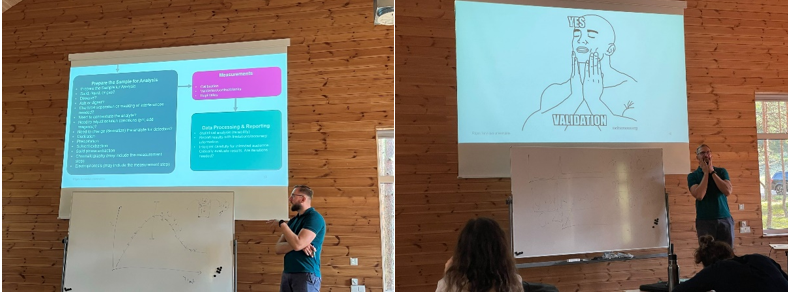
Afternoon of the 1st day continued with the lecture of Prof. Shahram Ghanaati on “Blood and Blood Concentrates: An autologous drug delivery system for tissue engineering”. Prof. Ghanaati is a specialist in oncological plastic reconstructive surgery and implant surgery for head and neck cancer patients, which offered an opportunity of presenting several examples of oncological pathologies and the recovery process of the patients during the lecture. The lecture also included certain cases of complications that can occur during tooth extraction and Prof. Ghanaati led a discussion about the biomaterials, useful and optimized for healing and tissue regeneration in the oral cavity.
During lecture, Prof. Shahram Ghanaati not only shared his experience as a surgeon, but also gave many advices on how to take care of our health –vitamin intake and their level in the body, blood analysis and the habits of adequate water intake. The afternoon session was brought to an end with a series of questions from the professor, where all the participants shared their impressions of the lecture and continued with the discussion on drug delivery systems for tissue engineering.
The 2nd day of Winter School: This day started with Prof. Christèle Combes and Fabien Brouillet presentations. They explained the concepts and examples of drug delivery systems in bone substitute applications, focusing in particular on particulates and matrix systems for ion and molecule delivery. For this purpose, they showed two recent studies they carried out on the topic.
Lecturers emphasized the importance of dealing with particulate systems as drug carriers, where the performance of the dissolution test, as described in EU regulation (M5.17.1) is needed. The lecture followed by stating the specifications of the main parameters: (i) the apparatus, (ii) the dissolution medium (composition, temperature and volume), (iii) the rotation speed and flow rate, (iv) the time/method/amount of sampling from the test solution, (v) method of analysis and the (vi) acceptance criteria. All these key aspects have an influence on the final result of the dissolution test and they allow the comparability of the results with other studies/publications. Fabien Brouillet also described the “sink condition” and the three main methods for in vitro drug release (Sample&Separate/Dialysis Membrane/FlowThroughCell), discussing pros and cons of each technique. Based on the drug release concepts described by. Brouillet, Prof. Combes showed two study cases reported in their recent papers about “Composition and properties of silver-containing calcium carbonate - calcium phosphate bone cement” and “Injectable bone cement containing carboxymethyl cellulose microparticles as a silver delivery system able to reduce implant-associated infection risk”.
After the lunch break and networking, afternoon continued with the hands-on training and group work based on the analysis of published papers based on the concepts of the morning lectures. All winter school participants were divided in groups and each group was given a different scientific study, with the goal of analyzing the drug loading strategy, drug release method and environment.
The 3rd day of the Winter School: This day started with the lecture from Dr. Sibylle Grad on “Delivery of therapeutics for intervertebral disc regeneration". Dr. Sibylle Grad started by introducing the participants with the structure of AO Foundation and with how the different departments are working on various challenges in bone regeneration, as well as how they collaborate on different aspects. The lectures continued with providing detailed overview of the intervertebral discs, its components and diseases associated with it. Moreover, current treatment techniques dealing with intervertebral regeneration and their potential drawbacks were discussed.
In the afternoon, group tasks were performed based on the analysis of a recent scientific article about the topic delivered in the morning session. All the participants were divided into four groups and the focus was placed on discussing: (i) Explanation of the background and rationale of the study, (ii) Thorough analysis of the experimental methodology and characterization, (iii) Protocol used for sample preparation and analysis of the results obtained during in vitro cell culture study, (iv) Sample preparation and analysis of the in vivo animal study. During this activity, the participants were given one hour to discuss about the respective questions. All the groups successfully answered the sub-questions from each task. The biological study section was difficult to understand but everyone overcame the difficulties.

The group activity was very informative and it brought closer the current status of research for restoring the normal functioning of the intervertebral discs to the participants. Moreover, the discussion also assisted in understanding the complex results of in vitro and in vivo studies. Finally, in the concluding remarks, Dr. Sibylle Grad gave valuable scientific insights about therapeutic strategies that need to explore for repairing intervertebral discs. The networking opportunity session also led to a scientific discussion between Dr. Sibylle Grad and participants for possible research collaborations.
RISEus2 1st Summer School "From laboratory to the market of medical devices"
21-25 March, 2022, ENSIACET – Toulouse (France): Institut National Polytechnique de Toulouse (INPT-CRIMAT)
The 1st day of Summer School: During the opening session Prof. Christèle Combes gave the foreword to all of the participants about the general information on the school “From laboratory to the market of medical devices”. All the partner organizations of the RISEus2 project were introduced (Riga Technical University (RTU), Johann Wolfgang Goethe-Universitat Frankfurt am Main (GUF), Institut National Polytechnique de Toulouse (INPT – CIRIMAT)), together with the labs/universities external to the RISEus2 project.
Following session was constructed as a roundtable where all the participants used the opportunity and introduced themselves in short 5 – 10 min presentations and emphasizing their both professional and personal background.
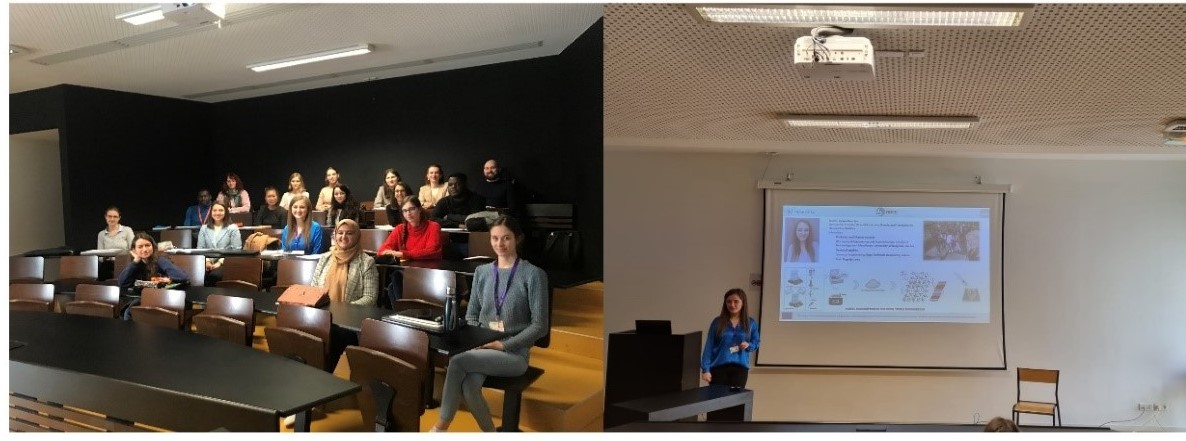
Afternoon continued with the lecture of PhD David Grossin on “Standards applied to biomaterials”, covering the ISO and ASTM standards. Definition of a standard, together with the key elements comprising them was explained and showing everyday items, built according to ISO, brought the entire subject of standards around us closer. Distribution and standardization on international, European and national level was discussed and the process of voting and becoming a member was applied on several examples. The afternoon session was brought to an end with a workshop where all the ESRs were divided in groups and searched for specific standards that would be beneficial in their respective fields. The first day ended with a social program with an official tour guide showing all the ESRs the old town of Toulouse, land marks and gave them detailed explanation of the history of Toulouse.
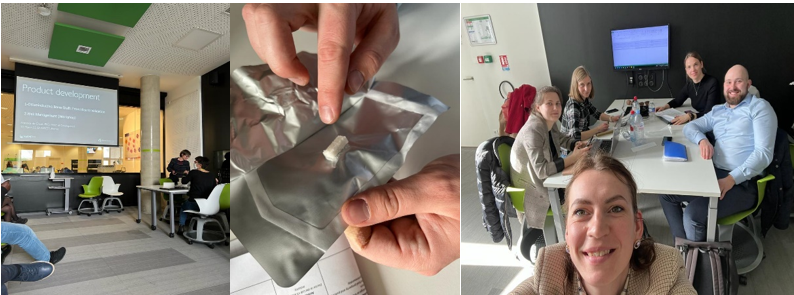
The 2nd day of Summer School: This day started with the presentation “Medical need and applied research: the contribution of 3D printing in head and neck surgery” performed by Agnès Dupret-Bories, Head & Neck Surgeon, University Institute of Cancer Toulouse Oncopole. During the presentation Agnès, revealed the working direction of the group of surgeons she belongs to and technologies they are using together with a qualified team of engineers from a company. The main direction of the company is aimed on jaw defect correction and healing. Jaw defects are very common bone malfunction disease among senior and/or indigent group of French citizens. Such defect causes partial loss of speaking function and complete inability to eat. Together with a group of surgeons, the company helps to overcome this issue by observing 3D printing strategy, calcium phosphate implantation and by using autografts harvested from patient fibula bone.
Second part of the day-two of Summer School continued with presentation “Osteoinductive bone grafts – Concept, Research & Preclinical validation” made by Florence Barrère-de Groot. Florence is working as the head of development and a risk assessment specialist in the company based in the Netherlands, however her background is also in biomaterials R&D area. Company’s main products are innovative osteoinductive bone grafts made of composite system of PEG/PLA co-polymer and β-TCP. This product came to the market some years ago and now company has clinical partners in world metrics.
Final presentation was performed by Aliassghar Tofighi. Aliassghar is a specialist in the calcium phosphate (CaP) field, he worked for a long time at Etex Corp. (Boston, USA) and he is now President and CSO of Innovoss Inc., Boston (USA). Aliassghar has worked as a reviewer in various journals focused on cements. Lecturer gave detailed story of CaP’s discovery and described the use of CaP’s in the medicine and industry. Aliassghar presented the definition of calcium phosphates, autografts, allografts and xenografts, and revealed all modern products that could be found on the market connected with CaP’s. The lecture finished with an active discussion on how to discover novel routes of placing CaP’s in the market as innovations.
The 3rd day of the Summer School: This exciting day started with a social activity to get more into French culture and tradition: about 2 hours of French cuisine cooking class, with a qualified Chef. During the cooking class, summer school participants were divided into two groups and had to prepare a starter and a main dish under the supervision of the Chef.
In the afternoon, three speakers from “Toulouse Tech Transfer” gave lectures about the technological transfer and innovation, intellectual property and patent, and entrepreneurship. Mr Jean-Marie Rigaud focused on technological transfer and innovation. The speaker pointed out how important it is for researchers to valorize their work and to transfer their knowledge by collaborating with companies/partnership research/etc. Moreover, he accentuated the significance of transferring their technology to a company/start-up by patenting their research results, and by creating a business in the light of their research outcomes. The key point to transfer successfully an idea to the market is to be innovative - meaning that one has to study the targeted market, understand its needs and limitations, and direct the focus to possible technological breakthrough. An innovation is something new, useful for customers and able to generate profit.
Mr. Gaston Nicolessi focused on entrepreneurship and start-up. The golden message is “There is not a protocol or a recipe to have a business idea!” The business idea has to be built-up (for example by observing with critical eyes what surrounds us). It might come from personal interests, because they are a comfortable field and it might be easier to recognize better criticalities and limitations. Finally, Mrs. Carole César gave a lecture on "Intellectual property and patents", fundamental legal tools with economical purposes to protect, but also valorize your research/work.
The 4th day of the Summer School: During the 4th day of the Summer School in the morning session, Professor Jean-Stéphane Condoret gave the lecture on “Technological transfer: The point of view of a researcher”. He first discussed about supercritical fluids, their definition and their main properties. More in-depth was explained about supercritical CO2 and its applications. In biomedical applications supercritical CO2 is used as a solvent or a cleaning agent (delipidation of bone implants). Professor Condoret explained how they developed new processes at a pilot scale, in collaboration with the companies. After the lecture, ESRs had the opportunity to see processes done in the laboratory reactor and pilot-scale reactors.
In the afternoon session, ESRs had two lectures. The first lecture was given by PhD Fabien Marcq, R&D manager at the company Teknimed SA (France). The main topic of the talk was “From idea to market”. The regulations and standards in the field of medical devices were introduced in detail. Specifics of MDR – medical device directive, were introduced to participants, along with the definition and classes of medical devices. PhD Anthony Maçon, who is Interventional Surgical Researcher Supervisor at company NAMSA (France), gave the second lecture. Macon talked about his own experience as a PhD in the Laboratory vs being a PhD in the industry. He shared his experience and main differences between academia and industry in the field of medical devices. PhD Maçon introduced his scientific background, and why he transitioned from academia to the industry.
The 5th day of Summer School: In the morning session, two invited speakers gave the lectures and presented their entrepreneurship. In the first lecture, PhD, Interventional Surgical Research Supervisor Anthony Maçon focused on “Biocompatibility and biological risk assessment in the world of medical devices”. The lecture discussed the definition of biocompatibility of a biomaterial, what can be referred as biocompatible and what cannot. The definition can be found in ISO 10993-1 (2018) “Biological evaluation of medical devices. Evaluation and testing of medical devices in the risk management process”. The general principles governing the biological assessment of medical devices in the risk management process, categorization based on the type and duration of their contact with the body, were discussed. The gaps in the available data set, based on the risk analysis were identified. Furthermore, additional data sets required to analyze the biosafety assessment of a medical device were mentioned.
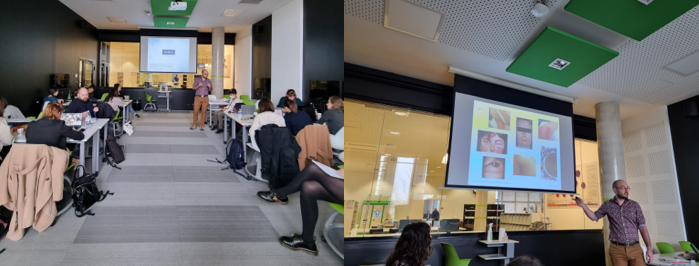
The second lecture was given by PhD, Postdoc researcher, Habib Belaid. PhD Belaid also shared his experience from materials to additives. He shared his experience in selling his scientific product, raising funds and the support that can be given through incubators. He delved into the distribution of money and time for his project stemming from marketing to research. In the afternoon session, PhD Anthony Maçon organized for workshop on “Biocompatibility and biological risk assessment for medical devices”. He introduced Risk factors that may be present in each class of biomaterials, also the pathway from laboratory development to the product packaging, was considered. Every step that can take place from the human factor to possible mistake is to be evaluated. The afternoon session was brought to an end with a workshop where all the ESRs were divided in two groups and they conducted an Oxford-style debate, where they were given separate tasks to defend and convince the audience in their point of view.
At the end of the day, it was concluded that after the lectures and workshops, more knowledge was gained about what was needed to bring the product to market. Participants also gained more knowledge about the need for ISO standards and patents that are needed to bring the product to the market. With this event 1st RISEus2 Summer School was closed.
RISEus2 1st Winter School “Calcium Phosphates and Composites”
The 1st Winter School on "Calcium Phosphates and Composites" was provided by internationally recognized RISEus2 partners: Frankfurt Orofacial Regenerative Medicine Laboratory, Goethe University Frankfurt (Germany), Institut National Polytechnique de Toulouse CIRIMAT (France) and AO Research Institute Davos (Switzerland) from 27th-29th of September, 2021.
The 1st day of Winter School: Prof. Shahram Ghanaati gave the lecture to participants about “The use of biomaterials in head and neck reconstructive surgery”. Such issues as quantitative bone composition within the human body and its connection to the replacement surgeries after cancer resection were discussed and analyzed. Impact of different factors influencing the outcome of the surgical procedures were reviewed as well as the importance of biomaterial type (bioceramic, hydrogel, metal implants) discussed and examples provided. Next lecture was given by Dr. Sarah Al-Maawi on “Cellular reaction to bone substitute materials and its influence on the regeneration process”, covering such topics as requirements for tissue regeneration, principles of guided bone regeneration, biological processes after biomaterial implantation, variety of biomaterials for soft and bone tissue regeneration and current classification of biomaterials. GUF scientists supervised the hands-on exercises to the ESRs related to the histology slide preparation and analysis.
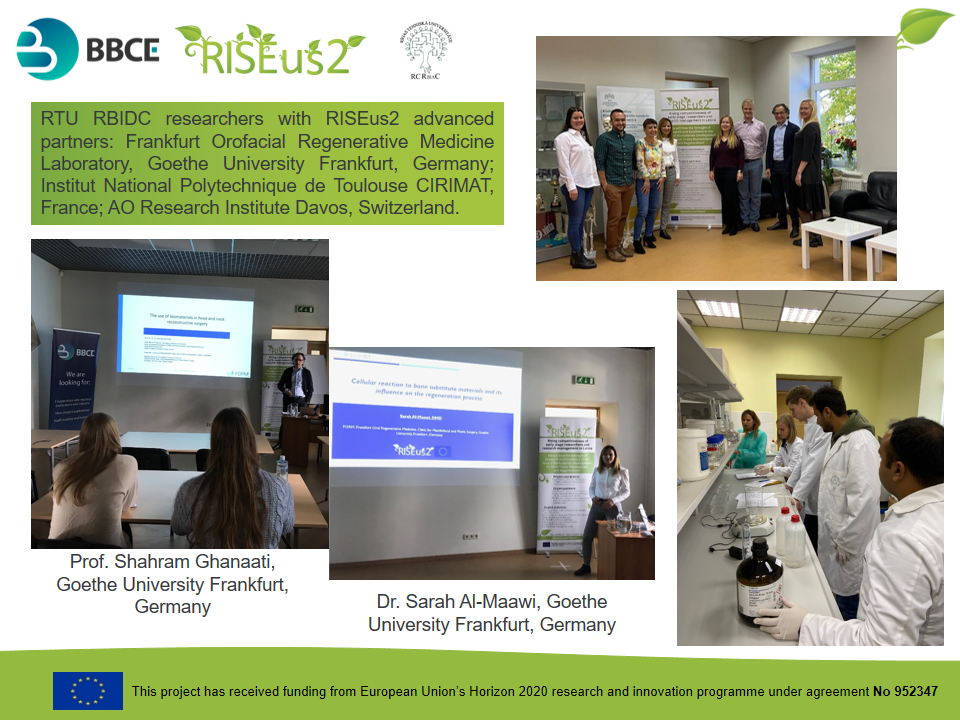
The 2nd day of Winter School: Dr. Jérémy SOULIE gave the lecture on “Fabrication processes and characterization techniques of porous biomaterials”. Beginning of the presentation was devoted to porous structures and how the solid matter can be classified based on the way to transport matter through these porous structures. Microporosity, mesoporosity and macroporosity were discussed in detail, highlighting such materials as zeolites and MOFs for microporous structures. The second lecture was given by Prof. Christian REY on “Characterization of calcium phosphates phases and materials by vibrational spectroscopy (FTIR and Raman)”. Insights in group theory was given and such aspects as practical group theory for vibrational molecular spectroscopy, symmetry operations and symmetry elements, remarks on rotations operation, molecular symmetry groups and examples on ammonia and water molecules were discussed. INPT-CIRIMAT scientists were supervising the practical tasks to the ESRs related to the porous materials and application of group factor theory to the determination of FTIR and Raman spectra of some calcium phosphate compounds.
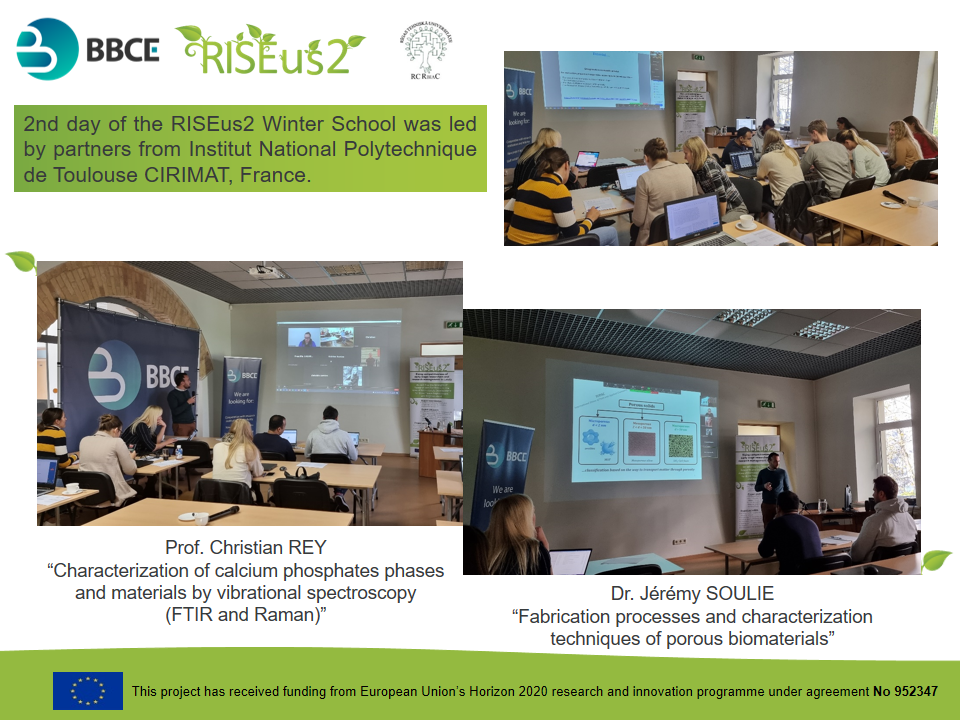
The 3rd day of Winter School: Research Scientist, PhD, Assoc. Prof. Andrea Vernengo and Master of Science ETH, Teaching Certificate Health Sciences Nadine Kluser gave an outstanding introduction in “Hydrogels and Hydrogel Bioadhesives: Tools for Tissue Repair”. During the interactive lecture, common biomaterial devices and biomaterials on the market were discussed as well as introduction into the biomaterial’s topic was given and multidisciplinary of biomaterials science was highlighted. Also, the introduction in hydrogels, their molecular structure and application possibilities were detailed.
Research Mobility 2023:
RTU RBIDC ESR Mobility visit to Germany
Visit focusing on basics of the cellular reaction to biomaterials with special focus on the biomaterial physico-chemical properties in vitro was implemented from 27.02.2023. – 17.03.2023 at GUR facilities by 3rd year RTU RBIDC PhD student Karina Egle. During this visit from RTU RBIDC side she is supervised by RISEus2 WP3 leader Arita Dubnika and from GUF side by Dr. Eva Dohle. Before the visit, Mg.sc.ing Karina Egle prepared a plan for the visit, which she will work on during the event, receiving approval from both RTU RBIDC and GUF supervisors.
On the first day of the visit, RTU RBIDC student Mg.sc.ing. Karina Egle together with GUF researchers Dr. Eva Dohle and Dr. Verena Hoffmann discussed future laboratory works during the visit. It was decided to use 3 donors for PRF extraction and one cell donor for the cell experiment at a cell density 50.000 cells/well.
During the first mobility week, PRF / hydrogel matrices were developed with FORM laboratory scientists and studied according to a previously developed plan. The plan was divided into 4 parts: growth factors, histology, immuno-histology, cell experiment. To create cell experiments, HDMEC cells were pre-cultured by Dr. Eva Dohle and split and counted on the day of the experiment. 50,000 cells were added to each well according to the experimental design and left to culture for 7 days.
The second week started with the planning of ELISA experiments and the preparation of the necessary reagents. Particular attention was paid to the choice of growth factors to be determined and how many samples/kits would be required. Also, the dilution of the samples according to the selected factor was chosen to determine each growth factor, so that it was possible to quantify each growth factor using the ELISA method.
In the third week, the cut samples were studied using the histology/immune-histology method. For the study of histology/immune-histology, different staining methods were investigated, which allow to study not only the distribution of PRF inside the hydrogel, but also to see whether the seeded cells as well as platelets, neutrophils and endothelial cells are visible in the prepared sample. In parallel, determination of additional growth factors was also performed for prepared samples using the ELISA method.
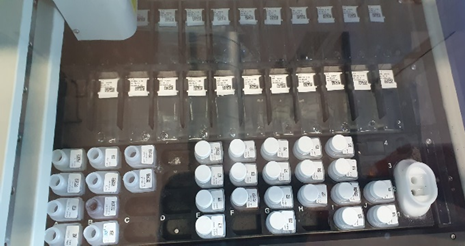
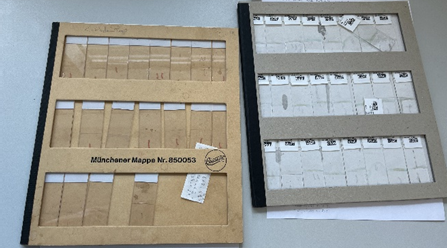
RTU RBIDC ESR Mobility visit to Toulouse - France
During the visit, young researchers focus on the improvement of technical and soft skills by learning new scientific methods and optimization models, by implementing different and possibly multidisciplinary approaches, and by exchanging ideas with international collegues having diverse backgrounds, etc
Anna Galotta, a third-year PhD student at RTU RBIDC, joined INPT-CIRIMAT research group from 06.03.2023 to 24.03.2023 to perform a detailed physico-chemical characterization of calcium phosphates composite to identify possible interactions between the ceramic and the polymeric material, and possible effects of cold sintering process parameters. The visit was organized and supervised by Prof. Janis Locs (RISEus2 project coordinator, RTU RBIDC) and by Prof. Christele Combes (RISEus2 project partner, INPT-CIRIMAT). Prior to leaving for the visit, an online meeting was held among the participants to discuss and structure the visit plan.
During the first day of visit, RTU RBIDC student Anna Galotta was introduced to the CIRIMAT research group and labs by Prof. Christele Combes. All CIRIMAT group members were welcoming and helpful.
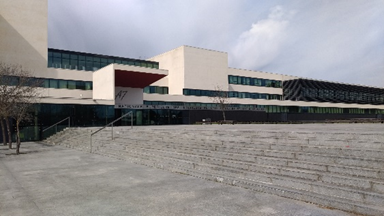
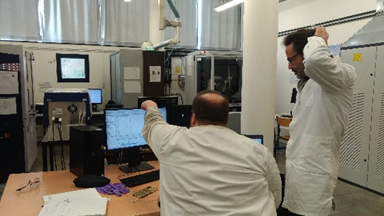
The first week was mostly dedicated to the data elaboration of the analysis performed in RTU RBIDC, to have a starting point for further investigations to be carried out at CIRIMAT. On Wednesday afternoon, the prepared powders (HAp/Chit/Sr-RAN) were observed by SEM with Prof. Combes (Fig.4). It was quite difficult to identify the organic matter in the composite samples, and therefore a session to FESEM was proposed to have high-resolution images.
At the beginning of the second week, Anna and Prof. Combes had the first meeting with Dr. Cedric Charvillat to discuss the preliminary diffraction results obtained at RTU RBIDC. Dr. Charvillat proposed to run the same analysis again to exclude any possibility of artifacts. In addition, an XRD assessment in parallel beam mode was scheduled for the pellets to determine if the applied pressure induce some kind of texture in the sample. During the meeting, the carbonate coulometric assay was also illustrated to allow Anna to prepare the samples accordingly.
The last week of visit started with the determination of carbonates content by coulorimetry. Thank to Dr. Charvillat guidance, the machine parameters were set and then the measurements were carried out by Anna independently.
RTU RBIDC ESR Mobility visit to Swizerland
This visit focuses on enhancing cell attachment on calcium phosphate-based biomaterials by coating the material. The experiments are conducted from 23.05.2023 – 19.06.2023 by Theresa Schiemer at the facilities of ARI. During this visit, she is supervised from the RTU RBIDC side by WP3 group leader Kristaps Klavins and from the ARI side by Mauro Alini and Shahranoo Jahangir.
On the first day of the visit, RTU RBIDC student Theresa Schiemer was introduced to ARI's laboratory facilities by Nora Goudsouzian and Shahrbanoo Jahangir. The exact scope and possible experimental procedures were discussed and planned. We decided to start with one pilot experiment to compare FBS coating with uncoated (PBS-treated) material. As a readout, we chose a simple 24-hour time point for life-dead staining, then imaging the cells using a confocal microscope.
In addition to setting up this first experiment, Theresa Schiemer participated in an in vitro laboratory training to operate in the lab independently. She was supervised by Shahrbanoo Jahangir for the whole period, who was always available for any questions and helped with the experiments.
In the second week, we used the same procedure with minor modifications. We used collagen type I coating (50 ug/ml in PBS) in addition to FBS and PBS. We chose the same coating procedure and viability readout but reduced the initial seeding density to 10^4 cells per sample. For this experiment, we used 3 time points (24 hours, 3 days, and 7 days). In addition, we checked the experimental well with light microscopy to determine floating cells and cells attached to the well bottom instead of the material surface.
In the 3rd week, we analyzed the day 7-time point of the coating experiment. We stained the material inside its original well and transferred it only for microscopy to image both the cells on the material and the well bottom. We used the tile imaging function to get a better overview of the whole disk. In addition, we planned one follow-up experiment to test the efficacy of our coating on cell adhesion. During this week, Theresa Schiemer was also introduced to the histology lab at the AO facilities. She participated in the staining of paraffin-embedded cartilage samples using SafranO and fast green staining. Nora Goudsouzian gave a general introduction to histology.
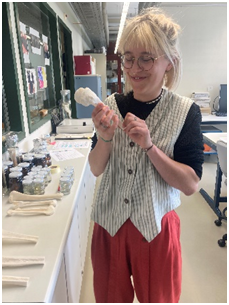
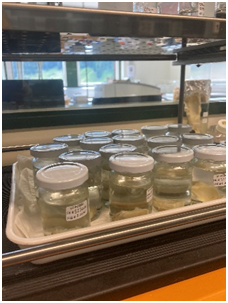
In the 4th week, we tested our coatings under harsher conditions by culturing cells on a shaker for 24 hours. In addition, Theresa Schiemer was introduced to 3D bioprinting at the AO facility. We used two inks with HMSCs inside GelMA and tyraminated hyaluronic acid (TyrHA). We set up the facility's bioprinter to print simple lines in a microchip.
Research Mobility 2022:
RTU RBIDC ESR Mobility visit to INPT-CIRIMAT
ESRs mobility visits are foreseen and planned to expand and strengthen their knowledge and professional experience, as well as their soft skills. With the secondments, ESRs gain personal experience in the international networking skills, overall research, and are taught how to implement the newly acquired innovation potential within the RTU RBIDC and society of Latvia. These visits are focused on the development of skills and knowledge on the new scientific models, facilities, optimization of methods, new directions, multidisciplinary approaches etc.
The secondment that will be described below, has been focused on the hands-on training on RAMAN and FTIR spectroscopy, as well as on optimizing analysis methods for various calcium phosphates. Second year RTU RBIDC PhD student Ilijana Kovrlija (further on referred to as ESR) implemented it from 07.03.2022 – 01.04.2022 at INPT-CIRIMAT (Centre Inter-universitaire de Recherche et d'Ingénierie des Matériaux) facilities. During this period, she was supervised by RISEus2 WP1 leader Dagnija Loca (from RTU RBIDC side) and by RISEus2 Task 1.2. leader Christèle Combes (from INPT-CIRIMAT side).
On the first day of the visit, Prof Combes presented the laboratory scheme, showed the available equipment and introduced the ESR to the other laboratory researchers. The day continued with the general safety training, provided by the expert Alexander Freulon. The training was finished with a written test to confirm the acquired knowledge.
 During the first mobility week, Dr Olivier Marsan performed extensive training on both Raman and FTIR equipment. Hardware and software of the equipment was shown and the most important details regarding independent usage and optimal calibration technique was demonstrated. In total, the training lasted for two days and from then on, the ESR performed the handling and all the subsequent analysis independently. Dr Marsan’s expertise and help was always available during the entire month of the visit. The plan of analysing was divided among three set of samples: formation kinetic of octacalcium phosphate (OCP), comparison of different calcium phosphates (CaPs) and drug loaded OCP.
During the first mobility week, Dr Olivier Marsan performed extensive training on both Raman and FTIR equipment. Hardware and software of the equipment was shown and the most important details regarding independent usage and optimal calibration technique was demonstrated. In total, the training lasted for two days and from then on, the ESR performed the handling and all the subsequent analysis independently. Dr Marsan’s expertise and help was always available during the entire month of the visit. The plan of analysing was divided among three set of samples: formation kinetic of octacalcium phosphate (OCP), comparison of different calcium phosphates (CaPs) and drug loaded OCP.
As a result of the mobility visit between INPT-CIRIMAT and RTU RBIDC ESR, two publications have been planned and their realization has already been set in motion during the period of the visit. Upon returning to Latvia, ESR has had three online meetings with the professors from CIRIMAT and during the meetings it was discussed how to best combine and structure the results gathered during the mobility visit.
Research Mobility 2021:
RTU RBIDC ESR Mobility visit to ARI
Visit focusing on the design of soft hydrogels and their composites with mineralized components for musculoskeletal regeneration was implemented from 21.11.2021- 17.12.2021 at AO Research Institute Davos (ARI) facilities by 1st year RTU RBIDC PhD student Eliza Tracuma. During this visit from RTU RBIDC side she was supervised by RISEus2 WP1 leader Dagnija Loca and from ARI side by RISEus2 WP2 leader Matteo D’Este.
27.10.2021 a web meeting was held among all involved parties to introduce ESR with the topic and to provide her with preparatory materials and to give a timely opportunity to prepare for eventual questions or agenda items.
Before mobility visit to ARI detailed plan of the trainings were discussed between RTU RBIDC and ARI. It was decided to work with three types of inorganic particles (amorphous calcium phosphate (ACP), hydroxyapatite (HAp) and α-tricalcium phosphate (α-TCP) and such polymers as hyaluronic acid (HA) and ɛ-polylysine (ɛ-PL).
On the first day of the visit at ARI (22nd of November), researcher Dr. Tiziano Serra's from ARI presented a lecture about “Sound-Guided Tissue Regeneration” and Dr. Geoff Richards introduced with the ARI institution. In the afternoon Nora Goudsouzian gave an extended ARI Tour and introduced to other ARI workers - researchers, doctors, and students.
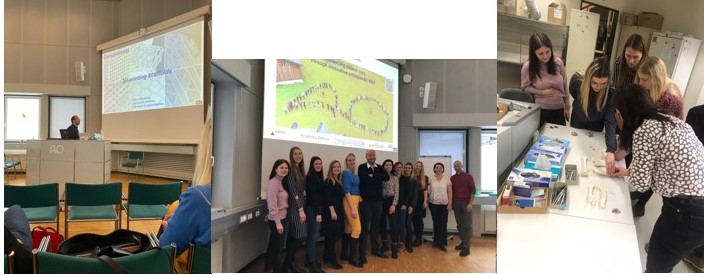
On the second day of the visit (23rd of November), Dr. Bektas presented his study “Delivery of small molecules via natural hydrogels for cartilage tissue engineering” and Dr. Zeiter presented “Design of in vivo studies for biomaterials musculoskeletal research”. After the lectures PhD Rotsiniaina (Roots) Randriantsilefisoa introduced me to the rheometer and we discussed the experiments, methods and the plan for the next weeks.
On the third day of the visit (24th of November), PhD Dr. Sibylle Grand gave a lecture about “The Role of Women in Science Technology, Engineering, Mathematics – and Medicine” and Root Randriantsilefisoa introduced her work about “Virus-responsive matrices as delivery systems”. After the lectures, Roots Randriantsilefisoa clarified the principles of rheometry and gave the hands-on training on rheometer.
On the 25th of November, hands-on laboratory work on bone fraction fixation techniques using medical devices was performed. After the laboratory work Technician of Biomedical Materials, Nicolas Devantay introduced the Polymer laboratory rules, safety, and working schedule.
On the fifth day of the visit (26th of November), Dr. Chittò gave a lecture about “Delivery of anti-infective agents with microparticles”. After the lectures, together with Roots Randriantsilefisoa practical work and training on the rheometer was done.
After this visit, the obtained results demonstrated the potential of HAp/HA/ε-PL composites to be used as bone regeneration materials as well as to act as ε-PL delivery systems, thus combining the promising features for more effective bone infection treatment. This investigation will be continued with the development of various CaP/HA/ε-PL compositions with different solid to liquid phase ratios, in order to discover the composition which could satisfy all the requirements for ideal bioink.
RTU RBIDC ESR Mobility visit to Germany
ESRs mobility visits are foreseen to expand and strengthen their knowledge and professional experience and therefore gain positive impact on the international networking skills, overall research, and innovation potential of the RTU RBIDC and society of Latvia.
Visit focusing on the use of platelet rich fibrin as a cell suspension in combination with biomaterials as a drug delivery system was implemented from 13.09.2021. – 08.10.2021 at Goethe University Frankfurt (GUF) facilities by 2nd year RTU RBIDC PhD student Karina Egle. During this visit from RTU RBIDC side she is supervised by RISEus2 WP3 leader Arita Dubnika and from GUF side by RISEus2 GUF representative Sarah Al-Maawi.
Participant Mg.sc.ing. Karina Egle had a virtual training before the visit at GUF. She was introduced to the topic and jointly with supervisors both from RTU RBIDC and GUF prepared a visit topic and a plan that she would work on during the visit (reports from both meetings are attached to the visit report).
On the first day of the visit, GUF researchers Dr. Sarah Al-Maawi and Dr. Eva Dohle presented the laboratory agenda, showed all the equipment and introduced to other laboratory researchers. Both researchers presented their daily work and introduced to research that they are currently doing.

Communication with national level policy makers
2021 was fruitful for communication with national level policy makers! RTU RBIDC leading researchers Prof. D.Loca and Prof. K.Salma-Ancane participated in the elections of new members of the Latvian Academy of Sciences (LAS) and presented scientific reports on their academic work and research activities. It was great opportunity to introduce the Members of the Latvian Academy of Sciences with RISEus2 project objectives and main activities.
Scientific Reports in Division of Chemical, Biological and Medical Sciences at the Latvian Academy of Sciences:
«Calcium phosphate containing biomaterials for bone tissue engineering and local therapeutic agent delivery» by D.Loca, 14.10.2021.
«Biomaterials for bone tissue regeneration» by K.Salma-Ancane, 21.10.2021.
We are excited that D.Loca was elected as Full member and K.Salma-Ancane as Corresponding member.
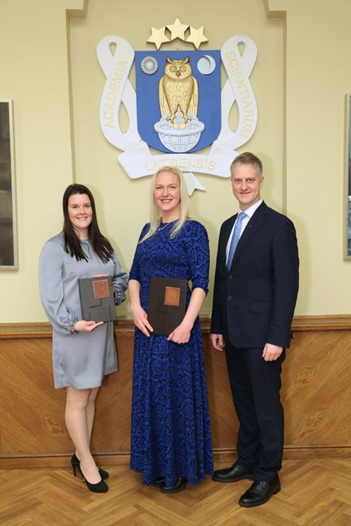
Popular Science Lecture
In order to attractively attract children and young people's interest in STEM - science, technology, engineering and mathematics, the RISEus2 project team in cooperation with RTU University of Children and Youth organized the 8th - 9th grade students' competition "Mysterious Science", creating online lectures and practical sciences experiments. The competition is organized with the aim to popularize chemistry and materials science among young people, as well as to organize meaningful leisure time. We hope to see them back in couple of years already as students.
The exciting open access lecture "Application of biomaterials in the human body" by RISEus2 WP4 leader Assoc. prof. Dr.sc.ing. Kristine Salma-Ancane and experiments in practical science is available online. /In Latvian/
RISEus2 kick-off meting - 8.02.2021.
On February 8, 2021, Riga Technical University (RTU) Rudolfs Cimdins Riga Biomaterials Innovation and Development Centre in close cooperation with internationally recognised project partners from Switzerland, France and Germany – AO Research Institute Davos (ARI), Institut National Polytechnique de Toulouse CIRIMAT (INPT-CIRIMAT) and FORM-Lab Frankfurt Orofacial Regenerative Medicine, Goethe University Frankfurt (GUF), Advisory Board Members, European Research Executive Agency and CScience & Innovation at the European Commission representatives, kicked off the 3-years project “Rising Competitiveness of Early Stage Researchers and Research Management in Latvia” - RISEus2 supported by European Union’s Horizon 2020 research and innovation programme (GA No 952347).
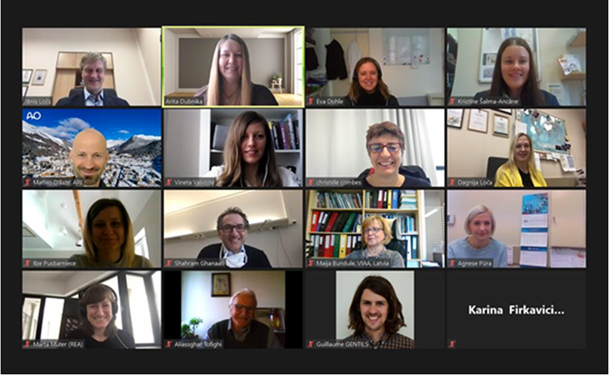
The aim of the RISEus2 project is to increase the research profile of early stage researchers and strengthen the research management capacity of leading staff at RTU Rudolfs Cimdins Riga Biomaterials Innovation and Development Centre in the area of biomaterials development for bone tissue replacement and regeneration. This will enhance international scientific competitiveness and attractiveness, as well as reinforce cooperation with industry and promote technology transfer and delivery of new products into the market.
Within the project, early stage and experienced researchers will gain new knowledge and explore approaches for research planning, implementation and exploitation of biomaterials. Two-way collaborative visits will be organised to enhance the mobility of the research staff. Additional activities will include winter and summer schools, workshops at the partner institutions, dissemination of research results and public awareness activities. The project is also intended to increase the interest and knowledge about biomaterials research for the general public by organising different dissemination activities for school children.
Highly trained scientists are the way to development and innovation in medical care and industry, stresses Professor Jānis Ločs – The Coordinator of the RISEus2 and Director of the Institute of General Chemical Engineering at RTU.
Acknowledgements: This project has received funding from the European Union’s Horizon 2020 research and innovation programme under grant agreement No 952347.
Twitter: Follow@RISEus2
Facebook: @RISEus2
BBCE project´s main objective is to establish a joint Baltic Biomaterials Centre of Excellence for advanced biomaterials development based on the long-term strategic cooperation between AO Research Institute Davos, Switzerland (ARI) and Friedrich-Alexander University of Erlangen-Nuremberg, Germany (FAU) on the one hand and RTU RBIDC, LIOS, RSU and RSU IS on the other hand.
